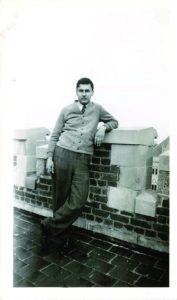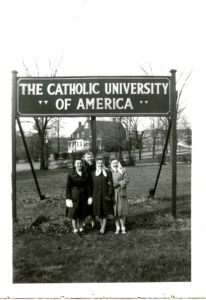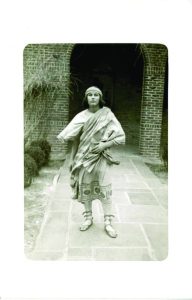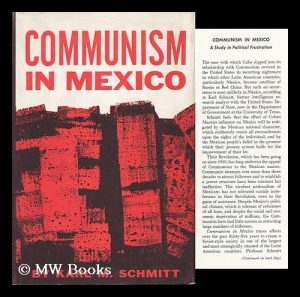
Kentucky born Karl Michael Schmitt (1922- ), a recent centenarian and alumnus of Catholic University, is a distinguished scholar and teacher on Latin American studies. Special Collections, which includes University Archives, is fortunate to have a small but important collection of Dr. Schmitt’s materials, mostly photographs, documenting his World War II era time on campus, with many outdoor group shots that are generally dated and persons identified. There is also an unpublished manuscript titled Changes at The Catholic University of America, 1940-2000: Some Reflections of an Old Grad.

Schmitt entered Catholic University in 1940 where he was mentored by Professor Manoel Cardozo while working in the library with Latin American related books, including the Oliveira Lima Library. While Cardozo was a ‘Brazilianist,’ Schmitt was drawn to Mexican history because of his interest in its Revolutionary history and due to a lifelong Mexican friend he met at Catholic U.(1) Schmitt also pursued extracurricular activities in theater, acting in three plays, before entering the World War II draft in early 1943. He served in the United States Army until September 1945, re-enrolling at Catholic U. upon his discharge. Becoming interested in student government, he was elected President of the Baltimore-Washington Chapter of the National Federation of Catholic College Students (NFCCS). Graduating from CatholicU in 1947 with a BA in History, he then earned an MA there in 1949.

After leaving CatholicU, Schmitt went on to a distinguished teaching career as a history and government professor, achieving his doctorate from the University of Pennsylvania in 1954. Leaving the U.S. State Department in 1958, he spent the majority of his career on the faculty of the University of Texas at Austin. He was also a visiting professor University of California, Los Angeles, 1959 and at the University of Manchester, England, 1988-1989. Additionally, he taught at the National War College, 1970-1971 and was a member of Texas Catholic History Association, serving as president 1976-1977.

Schmitt authored several books on Latin America, most notably Communism in Mexico: A Study in Political Frustration (1965), studied from the perspective of domestic politics to describe the internal structure of the movement and its relations with government and labor. He observed the fidelity of the Mexican Communist Party (PCM) to Moscow and discussed the movement’s weaknesses as a competitor for power in the Mexican context of modified democracy in a single-party system. He argued it was an orthodox Communist party whose membership was insignificant, blindly loyal to Moscow, harassed by the government, and ineffective in its political activity. The government combined toleration of deviant opinion with quick suppression of behavior threatening public order, with Schmitt concluding that Communism in Mexico would remain ineffectual unless a major depression occurred or the pressure of population increase became extreme.
See Dr. Schmitt’s extensive 2022 interview by Portal, the web magazine of the Llilas Benson Latin American Studies and Collections of the University of Texas He also wrote a letter dated 1/11/2022 to CatholicU updating his recent life and his collection at CatholicU has been digitized. Please direct any questions to lib-archives@cua.edu
(1) Portal, the web magazine of Llilas Benson Latin American Studies and Collections, University of Texas, 2022.
(2) Special thanks to Shane MacDonald for his work on the Schmitt digital collection.
